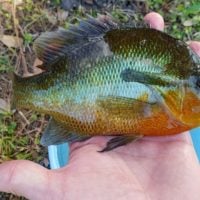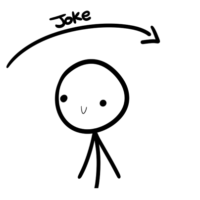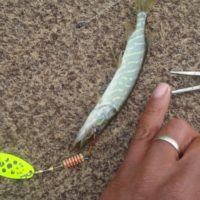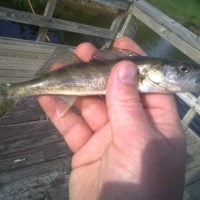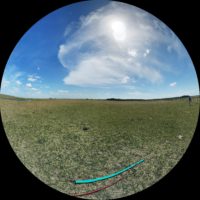http://www.growlermag.com/gotta-catch-em-small-growing-micro-fishing-trend-has-twin-cities-roots/
Gotta catch ’em small: Growing “micro-fishing” trend has Twin Cities roots
April 25, 2017 by Monique Kleinhuizen
Aaron Bye is a Stillwater-based home inspector who built his business around an extreme attention to detail. He found a fitting hobby, almost by accident, and coined the term “micro-fishing” on a 2009 trip when the fishing was slow.
“We were goofing around catching emerald shiners, and realized it was a ton of fun,” says Bye. “We started joking—calling it ‘fishing for minnows’—and using a macro camera setting to take photos. Then we were thinking ‘macro’…’macro’…then ‘micro’ came to mind.”
subculture has since developed around a style of fishing more akin to collecting baseball cards or rocks than trophy-hunting, because the goal is to hook as many micro species as possible. In general, “micros” are defined as species that never reach a pound. They lure fishermen—most of whom have gotten to know each other locally—to spots many overlook, in search of the most overlooked fish.
“I have literally fished in a drainage ditch in the parking lot of a shopping center. I’ve gone wading in lakes, small streams—anywhere there are minnows,” says Bye, who packs a tiny tool kit, bobbers and tackle when he goes out. He’s used dead mosquitos for bait, or cuts a minuscule piece of worm with surgical scissors. “Baiting a hook is sometimes a challenge,” he says, “but you can fit your gear just about anywhere.”
Finding a keeper is kind of a moot point, so most photograph their catches for online “lifelists,” often on roughfish.com. There, members with aliases post photos of each species they’ve caught, all feeding into region- and size-based aggregate lists that illustrate the wide variety of fish out there, both standard and micro.
Bye once ran an online contest called Micro Madness, where competitors had four months to photograph as many species as possible. To prevent cheating, a “control button” was provided just before the contest and needed to be present in each photo.

Stickleback // Photo by Aaron Bye
One roughfish.com member in British Columbia boasts 162 micro-species to date, while an Eau Claire-based angler has an impressive 132, ranging from a hornyhead chub to a knobfin sculpin. Each entry has information about the fish, such as a photo, the scientific and common name, a date, and pertinent notes about the bait, location, or season. A school of online forums and Facebook groups have sprung up for sharing tips and photos. There’s even a vendor out there who creates micro-mounts—which are actually tiny replicas—but most release the tiny fish immediately after photographing them.
“People think I’m either nuts or joking,” Bye says of his hobby. “Then they go, ‘Oh my gosh, you’re serious. This is actually a thing!’ Most people will never understand. But believe it or not, they do hit pretty good. They’ll take down a bobber.”
Alex Orr of Hugo—who was with Bye the day the term “micro-fishing” was coined—says micro-fishing is a good way to gain a better understanding of specific water ecosystems.
“You get an intimate knowledge of the system of water you’re fishing in—there are lots of cool minnows out there. The nicer the creek, the cooler the fish,” Orr says. He recalls one proud moment when he landed a creek chubsucker, for which he had to “sit like a crane for a half hour—in blinding sun, sweating my ass off,” he says. “It took some serious finesse to get it.”
He says the sport has honed his technique for traditional fishing, too. “I’ve been made fun of by walleye fisherman […] but I’ve probably caught bigger fish than they have. Big or small, I catch ’em all,” says Orr.
His friend and micro-fishing travel buddy, Northfield-based Greenwood Vytautas Champ, is a self-described lifelong biology nerd who took up the sport specifically for its esoteric qualities.

Micro-fishing // Photo by Alex Orr
“We go after the ostracized fish […] all the little guys nobody else cares about. I was raised by a semi-hippie-ish family. I was homeschooled and allowed to follow what I was into,” says Champ. He had always been fascinated by reptiles and insects, and when he moved to Minnesota from Evanston, Illinois, he quickly realized fishing was the focus here. He now fishes the Root, Cannon, Mississippi and Zumbro rivers and has also tried the North Shore. “But it’s almost an obsession with the fish themselves,” he says.
Sometimes that obsession isn’t quite understood by the mainstream population. “The funniest thing is when you’re down South and some rednecks come driving by and see you standing in a cow ditch somewhere,” says Orr. “Anywhere you live, chances are there’s a little creek with some kind of minnows in it. And you don’t need fancy equipment.”
Specialized equipment is out there, though, including tiny tackle and specially-shaped hooks made for Japanese tanago fishing, which has been around for centuries. New York-based Chris Stewart developed tenkarabum.com and has become an import middleman for the growing number of American micro-anglers seeking specialty gear.
“I’ve never bought micro-tackle in a physical location,” says Champ. “Nobody stocks this stuff in stores.”
As for special rules or regulations? The DNR confirms that targeting small fish is no different than any other kind of fishing, at least when it comes to the law. As long as someone has a valid fishing license and lawful access to the property on which they’re fishing, they’re free to micro-fish.
